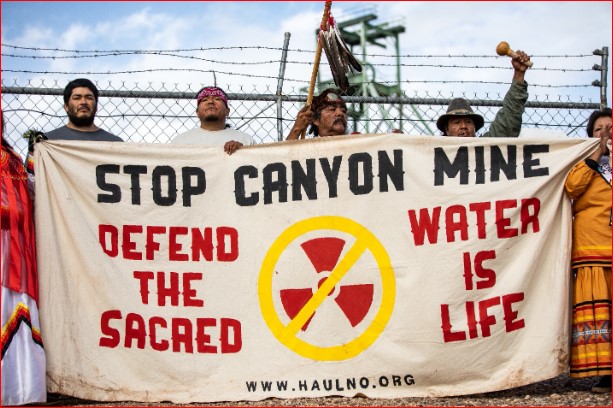Pinyon Plain Mine (formerly known as Canyon Mine) is a uranium mine located seven miles south of Grand Canyon National Park that poses significant threats to its surrounding region, including Grand Canyon and its life-giving springs.
Protect Grand Canyon from Uranium Mining

Havasupai Tribal members protest at Pinyon Plain (formerly Canyon) Mine -- (Photo courtesy Ed Moss)
Background & Summary:
Although a temporary 2012 Department of Interior order bans new mines within a one million acre region surrounding Grand Canyon for 20 years, approval for Pinyon Plain Mine dates back to 1986. This has allowed it to resume operations in recent years under outdated guidance and without Tribal consultation. During the construction of the mine in 2016, it struck an aquifer and has been flooding with millions of gallons of water each year.
Water samples from the site have been shown to contain dangerously high levels of arsenic and uranium. Much of this water is pumped to a surface containment pond that attracts local wildlife, but the aquifers beneath the mine remain at risk. This groundwater likely connects to water sources in Grand Canyon and the water supplies of nearby communities.
Pinyon Plain Mine sits within the Red Butte Traditional Cultural Property, an area of critical religious and cultural importance to multiple tribes, particularly the Havasupai.
The dangers and risks associated with the Pinyon Plain Mine follow a pattern of other mines in the region, including the Pinenut Mine that left high levels of contaminants in the soil and the Hack Canyon Mine that spread waste into nearby water sources.
Links:
- 80 Groups, Scientists Urge Arizona Governor to Close Uranium Mine in Newly Designated Grand Canyon National Monument
- Uranium Mine Gears Up Near Grand Canyon National Park: Senate must pass Grand Canyon mining ban before 117th Congress ends
- Conservationists Back Havasupai Tribe’s Opposition to Grand Canyon Uranium Mine
- Arizona OKs Uranium Mining Permit That Puts Grand Canyon’s Groundwater, Springs at Risk
- Handout PDF "Pinyon Plain Uranium Mine (formerly Canyon Mine) Threatens Grand Canyon: Water, Wildlife, and Cultural Resources At Risk"
- Pinyon Plain Mine (formerly Canyon Mine) Non-Storm water Impoundment 3.04 General Aquifer Protection Permit No. P-100333 Annual Report for 2020
- ADEQ Documents
- Sierra Club et al. Canyon Mine APP Comments
- Havasupai Canyon Mine APP Comments
- Tom O'Halleran's Letter to ADEQ
- Letter to ADEQ from Arizona Indigenous People's Caucus